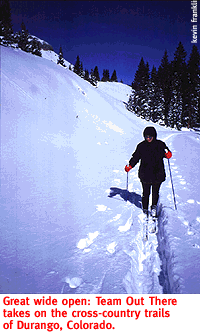
By Kevin Franklin
THE ICY AIR shudders with the report of an explosion echoing
through the snowy mountains.
 As soon as the thundering fades, absolute silence returns. Nothing
stirs among the snow-covered pines.
As soon as the thundering fades, absolute silence returns. Nothing
stirs among the snow-covered pines.
"What was that?" asks Yvonne Mery, fellow Out There
snow surveyor.
I think it was cannon fire, trying to jar loose snow from the
slopes in a controlled avalanche.
All around us are immense peaks reaching beyond 14,000 feet.
The guy who rented us the cross-country skis also advised us to
watch out for avalanches. His cautionary tone seems more warranted
now than it did back in the store. The cozy little town of nearby
Durango, Colorado, is a world away from the snowbound slopes around
us.
"What are you supposed to do in an avalanche," Mery
asks my brother Ken, a resident of Durango.
"Avoid them," he replies, "unless you're James
Bond--then you outrun them while all the bad guys from Specter
are consumed by it."
We've come to Durango to visit Colorado kin and get some skiing
in before the year slips by with nary a pole in the snow.
Cross-country skiing is pretty much an alien sport for Arizonans,
but it has a lot of redeeming qualities worth checking out. First
of all, the actual act of skiing is free. Once you rent or buy
your gear, you don't have to worry about buying a lift ticket.
Second, cross-country skiing makes for some of the best aerobic
exercise around--just ask a NordicTrack zealot.
 But perhaps best of all, cross-country skiing allows you to get
out and explore terrain cut off from folks in boots or on wheels.
But perhaps best of all, cross-country skiing allows you to get
out and explore terrain cut off from folks in boots or on wheels.
If you take off from the major cross-country ski routes, you
may not see anyone all day. Trails that in warmer months resound
with the pounding of vibram treads and fat-tire bicycles wait
silently for a pair of long skis to glide over them.
Being unfamiliar with the area, we followed the ski shop guy's
advice and drove into the San Juan Mountains. Now we're sliding
our way around Little Molas Lake, about 25 miles north of Durango.
The detonations we hear are, in fact, avalanche reduction activities,
says Scot Toepfer, Colorado Avalanche Information Center mountain
weather and avalanche specialist. But instead of cannon fire,
employees of the Colorado Department of Transportation are dropping
bombs out of a helicopter onto slopes threatening Highway 550,
he says.
From television and movies one might think avalanches occur only
on the slopes of Himalayan-sized peaks, but Toepfer says most
deaths occur from small movements off slopes as small as 25 feet.
"We've had five deaths (in Colorado) so far this season,"
Toepfer says. "If you're at the bottom of a gully with 25
feet of snow above you, and that comes sliding down, you can get
buried pretty easily. Short slopes can kill you."
Toepfer suggests staying away from slopes with angles from 25
to 45 degrees unless you're familiar with avalanche conditions.
If you plan to spend much time in the backcountry, you should
take one of the avalanche awareness courses offered around the
state.
After a few hours of clowning around on the snow-covered frozen
lake and valley (a good place for neophytes to hang out), we head
back to Durango in quest of hot chocolate and a good night's sleep
before assailing the slopes of Purgatory Ski Resort tomorrow.
GETTING THERE
If you can find the time, Durango makes a hell of a road trip.
Follow Highway 77 north past Globe, across the San Carlos Apache
Reservation, down into the Salt River Canyon, across the Fort
Apache Reservation and on to the forested slopes around Show Low
or Hollbrook. This makes a good first leg. The second day, Interstate
40, Highway 191 and 160, will take you past the Petrified Forest
National Park, the Painted Desert, a large chunk of the Navajo
Reservation, Canyon de Chelly, the Four Corners Monument and Mesa
Verde National Park. Oh yeah, almost forgot, Monument Valley and
Shiprock Mountain can be seen in the distance, too.
GETTING BACK
The Colorado Avalanche Information Center has a list of places
to learn avalanche safety. To have them fax you that information,
call (303) 371-1080. For current weather and avalanche conditions
in the San Juan Mountains near Durango, call (970) 247-8187.

|
